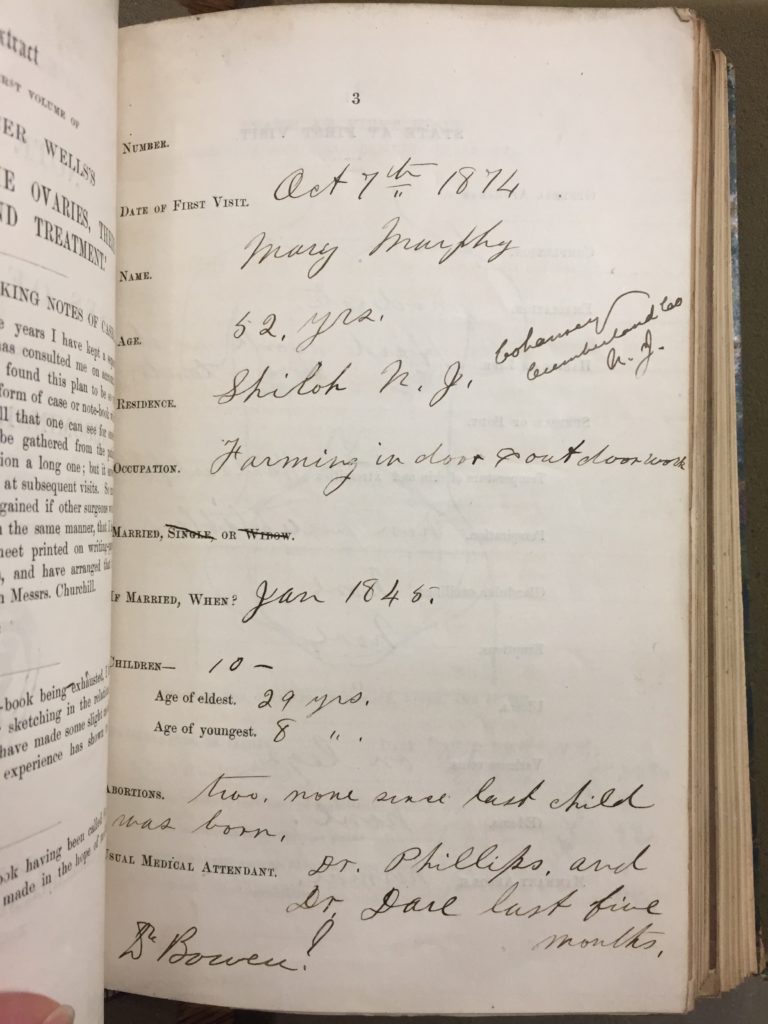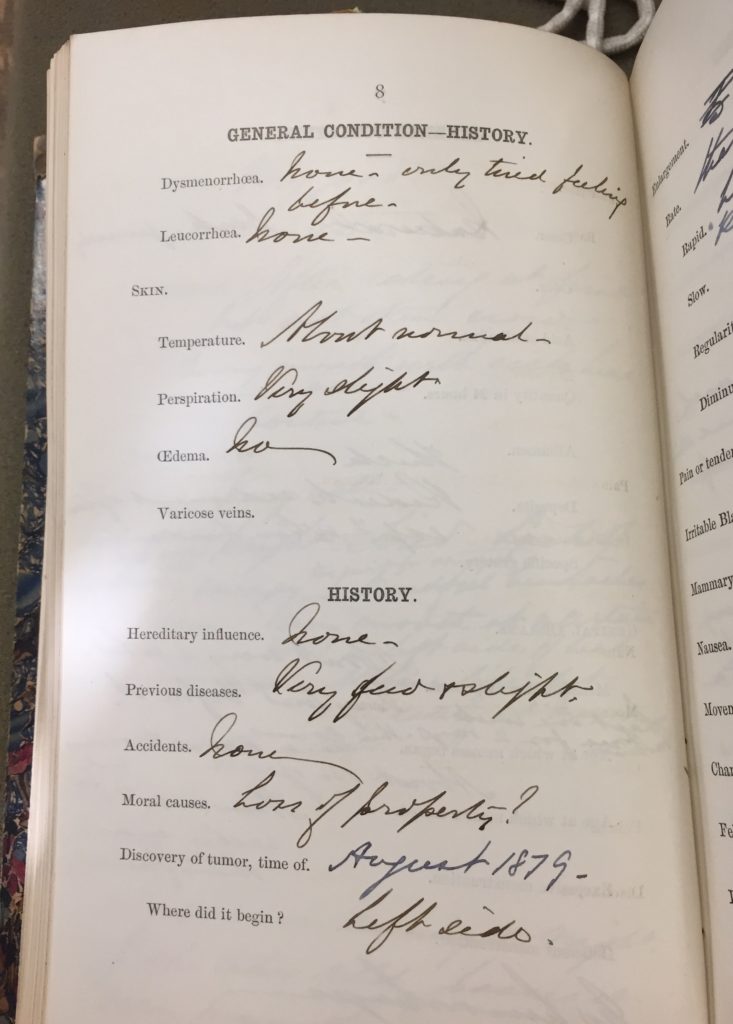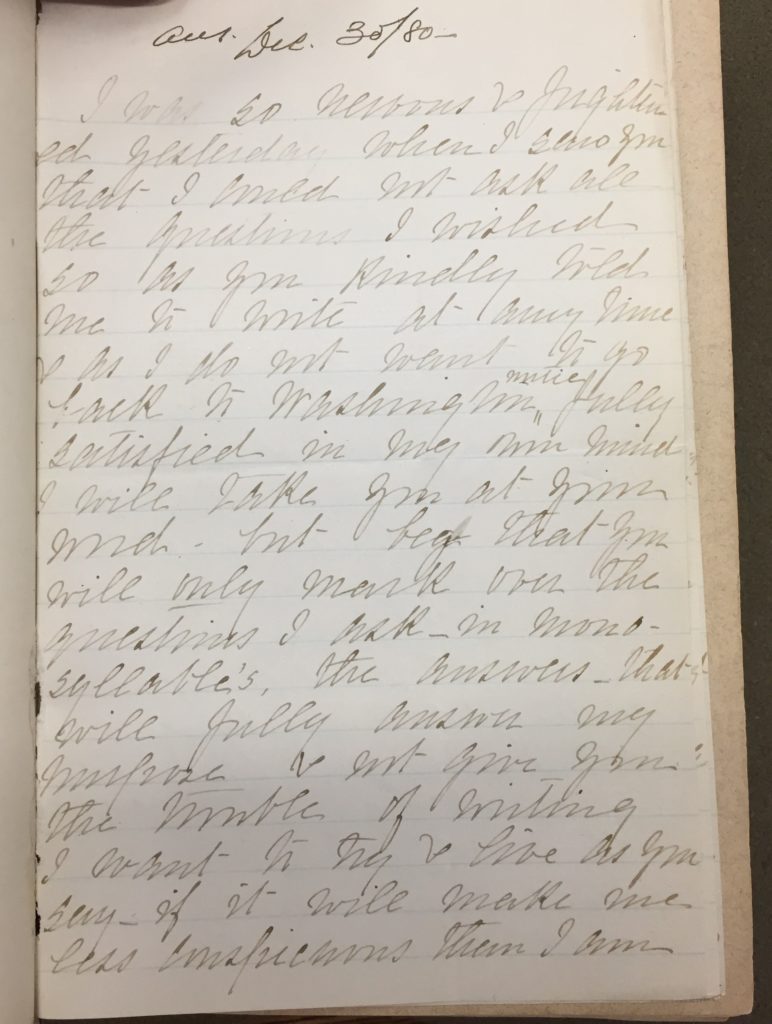– by Wood Institute travel grantee Annelle Brunson*
Cracking open the accordion-notebook of Dr. Hugh Lenox Hodge (1836-1881), I read from the top, thumb and index finger poised delicately at the faded yellow corners. Each turn of the page wafts the familiar musty odor of the archives. Each page brings another woman in distress. Hodge was one of the leading doctors of female diseases in nineteenth-century Philadelphia. His entries can seem vaguely impersonal, a simple version of the forms we fill out today: name, age, address, family members, symptoms, and physical notations. Unlike today, his diagnoses carry a heavy weight of non-scientific judgment.
Nineteenth-century doctors, almost exclusively male, entertained peculiar ideas about the female body. Hysteria was at its diagnostic climax, reproduction was at the root of all women’s ills, and terminality was still a gift and a punishment from God. But what intrigued me most were the documents inter-leaving the accordion; the correspondence from female patients, who offer a very different view of the patient experience. Their letters appear carefully composed but the ink blots at the ends of sentences and words suggest an occasional hesitation, a desire to get this right—and they tell a deeper story of the women’s lives read in-between the lines.
Evolving from a long tradition of family care, specialists in women’s diseases were typically chosen through familial connections or friendship ties. Women’s letters to their gynecologists overwhelmingly strike a grateful and familial tone, despite their medically specific and personal content. They seem to be a cross between a clinical reporting of symptoms and a prayer and a hope for intimacy and aid.
Thirty-eight-year-old Virginian Fanny Dickins went to see Dr. Hugh Lenox Hodge in 1873 on a visit to Philadelphia before heading home via Washington. Philadelphia, it should be noted, was the leading center of medicine in the antebellum United States, a reputation that survived the Civil War. Despite its northern geography, the city provided commingling grounds for the wealthy aristocratic society and a stream of immigrating southerners, particularly those arriving to learn or teach medicine. Fanny Dickins likely sought Dr. Hodge’s care because of his reputed specialization in female diseases, and because she felt comfortable enough doing so as a southerner.
Dickins’ first visit failed to prove the open sharing environment conducive to a thorough examination. She wrote in a follow up letter, “I was so nervous & frightened yesterday when I saw you that I would not ask all the questions I wished, so as you kindly told me to write at any time,” followed by a laundry list of questions and ailments. Here the letter form provided Dickins a sense of anonymity not granted in her face-to-face visit, making it easier to share her thoughts. As opposed to Mary Hopkins who began her letter, “I as usual must address you as a poor misfortunate afflicted being and only wish to God that I was where I could consult you personaly.”[1] Not all women divulging distinctly female ailments wished to maintain their anonymity, but in certain cases, it allowed them a space to share more freely. Others eased their fears by partnering with like-situated women to seek medical attention.
The gender dynamics at play in the male-doctor and female-patient relationship were not lost on those living in the nineteenth century. A pamphlet from Dr. Charles Meigs in 1854 lectured “no one will deny that the delicacy of those relations that exist between medical people and their female patients, opposes, in a variety of cases, an insuperable barrier against any successful treatment whatever, for there are found individuals so fastidious as to prefer pain, disease, and even death itself, to any revelation concerning their disorders.”[2] Meigs and other practitioners of the period believed that while the gender dynamics created a unique challenge, it was exactly that, a challenge to be overcome.
Mary Murphy, a mother of ten children who also had two abortions, was diagnosed by Dr. Hodge with a cyst of the broad ligament in 1874, at which time he noted her acclimation to “hard work farming.” Three years later, Murphy wrote to him from her home in Cohansey, New Jersey, to ask his opinion on a doctor claiming to know him and to have “a shure cure.” She relayed, “he could not cure me by medencine…but he would do it by barreing and useing ointment.”[3] Hodge reported in his journal upon reading the letter that she “is now in the hands of a quack.” While the contents of his letters to her are unavailable, he followed up on her case in 1879 when he noted she “is still able to do her work.” [4] Dr. Hodge’s final entry reveals his priority to keep her in a position to continue working. No matter his pragmatic motivations, Mary Murphy felt comfortable enough with him to seek his opinion and to divulge deeply personal information in her trials of life.

Beyond risky surgical removals, treatment options for abdominal tumors were limited. Tapping—the draining of surrounding fluid—both minimized swelling and served to determine malignancy. “It generally affords us undoubted information of the presence or absence of ovarian disease, aids us in detecting adhesions, and in deciding upon the true character of the tumor.”[5] Unfortunately, tapping had a lot of unforeseen consequences. Mary Murphy had to have eight procedures within a three-year span. “Tapping is a very dangerous means of palliating ovarian dropsy,” one doctor warned, “that when it is had recourse to, it will have to be frequently repeated; that the relief afforded between each operation will become gradually less, and the dangers consequently greater.”[6] While women often wrote about their desire (or lack thereof) to undergo surgical removals, very seldom did they proffer thoughts on slightly less invasive treatments like tapping.
Grappling with terminal prognoses, many women felt an attachment to their gynecologists—the men who knew more about their bodies, and often their feelings, than anyone else. Uterine cancer patient Julia Gilmer wrote to Dr. Hodge from her home in Charlottesville, “I do wish he knew how to mix the ergotine with glycerine & keep it in a bottle as you did. You remember there was no pain when you administered it. Now Dr. D takes out some of the solid ergotine, spends fifteen minutes mixing it with water, grinding it with a glass stick. I get so unusually nervous fearing he will put ground glass in me.”[7]
Terminal women, their families, and their doctors sought to make meanings from the cancer that would claim their lives. And yet the vast distance between genders, between a doctor and his patient, proved impossible to close. Dr. Hodge listed “loss of property” as a possible moral cause for Fanny Dickins’ tumor.[8] In the case of Mary Murphy, he deemed her mental status “good,” and under neuralgia he put “not now”; under hysteria he said “no,” then struck it out and said “yes.” He further postulated that the reversals in her health resulted from the “death of [her] brother last summer causing almost loss of mind.” Hodge was not alone in his relative blindness. His professional brethren attributed female cancer to punishment from God for not actively reproducing. In 1869, English doctor John Epps claimed that the “first condition for cause of ovarian disease was ‘singlehood’” and the “best way to avoid disease is, that every organ be used as He in His wisdom intended.”[9] Epps thinking, while not the rule, was common among Victorian physicians.
Readers of Dr. Hodge’s casebooks at the Historical Medical Library will be transported to the medical world of 1870s Philadelphia, a period in which medical advancement proceeded side-by-side with gender assumptions that needed to be lived down. In the pain, suffering, and silences within his notebooks, we find much to lament—and much to be thankful for.
Notes:
[1] Mary Hopkins to H. Lenox Hodge, September 18, 1880, H. Lenox Hodge Casebooks (10b 57), Historical Medical Library of The College of Physicians of Philadelphia.
[2] Charles Deluncea Meigs “A treatise on Acute and Chronic Disease of the Neck of the Uterus” (1854): 21, Historical Medical Library of The College of Physicians of Philadelphia. Meigs’ notoriety came from his belief that doctors could not contribute to childbed fever, because doctors were gentleman, thus their hands were clean. Another adamant principle of his was the rejection of parturition anesthetics because of his belief that the Divinity intended for women to feel pain during childbirth.
[3] Mary Murphy to H. Lenox Hodge, November 17, 1877 and November 21, 1877, H. Lenox Hodge Casebooks (10b 57), Historical Medical Library of The College of Physicians of Philadelphia. According to the 1880 Federal Census, Mary Murphy suffered from ovarian dropsy.
[4] H. Lenox Hodge casebook, November 19, 1877 and April 22, 1879, H. Lenox Hodge Casebooks (10b 57), Historical Medical Library of The College of Physicians of Philadelphia.
[5] Washington Atlee, “General and Differential Diagnosis of Ovarian Tumors” (1873): 47, Historical Medical Library of The College of Physicians of Philadelphia.
[6] Thomas Safford Lee, “On Tumors of the Uterus” (1867): 183, Historical Medical Library of The College of Physicians of Philadelphia.
[7] Julia Gilmer to H. Lenox Hodge, January 6, 1877, H. Lenox Hodge Casebooks (10b 57), Historical Medical Library of The College of Physicians of Philadelphia.
[8] Fanny Dickins to H. Lenox Hodge, December 1880, H. Lenox Hodge Casebooks (10b 57), Historical Medical Library of The College of Physicians of Philadelphia.
[9] John Epps, “Ovarian and Womb Diseases” (1869): 89, Historical Medical Library of The College of Physicians of Philadelphia.
*Annelle Brunson is an MA candidate at the University of Georgia. She received an F.C. Wood Institute Travel Grant from the College of Physicians of Philadelphia in October 2018.


